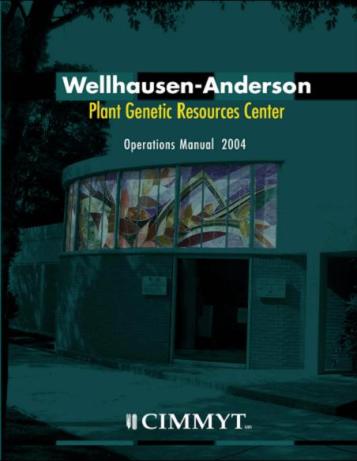CIMMYT (Maize and Wheat) genebank operations manual
 |
Download this manual in pdf format here (0.5MB)
This manual might be interesting or useful for readers to see how operations at the genebank of the International Maize and Wheat Improvement Center (CIMMYT) are conducted.
In 2004, CIMMYT restructured its research programs into six new global and ecoregional programs. One of these, the Genetic Resources Program, is now home to CIMMYT’s maize and wheat germplasm banks. This new organizational structure indicates the high importance and visibility that CIMMYT places on our role as custodians of maize, wheat, and related species genetic resources.
One of the first priorities of the program was to update the operations manual for the germplasm banks. The result of this effort is this publication, the Wellhausen-Anderson Genetic Resources Center Operations Manual. The policies and procedures outlined in the manual represent those currently being used in the introduction, evaluation, maintenance, regeneration, and distribution of genetic resources at CIMMYT. By following these procedures, CIMMYT ensures that the genetic resources entrusted to it in its germplasm banks are available to the world and that they maintain their genetic integrity while under CIMMYT's custodianship.
Contents
Preface
I. Background
A. Description of Maize and Related Species
A.1. Importance of maize for global food security and research
A.2. Origin of the maize
A.3. Centers of diversity
B. Description of Wheat and Related Species
B.1. Importance of wheat for global food security and research
B.2. Origin of the wheat
B.3. Centers of diversity
C. History of CIMMYT’s Germplasm Bank
C.1. Maize
C.2. Wheat
C.3. Wellhausen-Anderson Plant Genetic Resources Center
D. International Laws/Agreements that Affect Genetic Resources
II. Genebank Operations
A. Physical Infrastructure
B. New Introductions/Accessions to the Maize and Wheat Collections
B.1. Maize: guiding principles for new introductions
B.2. Wheat: guiding principles for new introductions
B.3. Introduction of new materials
C. Seed Viability and Germination Tests
D. Regeneration of Introductions/Accessions
D.1. Maize regeneration
D.2. Teosinte regeneration
D.3. Tripsacum regeneration
D.4. Wheat regeneration
E. Evaluation of Maize and Wheat/Accessions
F. Shipments
F.1. Maize
F.2. Wheat
G. Back-up Collections
G.1. Maize
G.2. Wheat
H. Data Management
H.1. Maize
H.2. Wheat
I. References
Comments
- No comments found





Leave your comments
Post comment as a guest